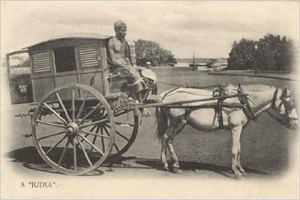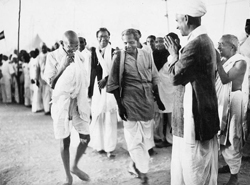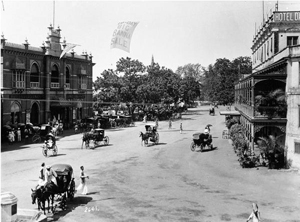My fascination for Madras dates back from my childhood seventy years ago.
In 1935, as a boy of seven living with my grandparents in Ariyalur, then a small village, I had the first glimpse of the great city, when grandfather took me there during X-Mas holidays to my aunt’s house at Purasawakkam
At Egmore railway station I felt I was transported to a fancy land of electric trains, taxis, and coaches. There were no auto or cycle rickshaws at that time only hand pulled rickshaws and jutkas.

A jutka, carrying four of us and luggage took us to Purasawalkam and the fare was only then annas.
Purasawakkam was my first acquaintance of Madras. Nearby Vepery was mainly a colony of Anglo Indians. There were many bakeries and confectioneries (notable among them was “Paldona” Shopping centre). Crowded Thana Street, Tram from Vepery to Central, Roxy Theatre showing only English pictures, were the important landmarks of the area. There were twin theatres Lakshmi & Saraswathi in the Perambur Barracks Road where my cousin and I saw “Nallathangal” movie in Lakshmi Talkies. Gala exhibition usually held during X-Mas season drew large crowds at SIAA grounds near Moore Market.
Tram services in those days were very popular and I felt funny when I found invariably all the drivers and conductors of the trams sported big “namams” on their foreheads. Both eco-friendly and absolutely accident free in the slow moving trams one could easily board or get off anywhere from the moving tram. In fact I remember a joke that appeared in the front cover o Ananda Vikatan making fun of the slow moving trams. Two men were conversing. One of them declined to accompany the other in the tram. He preferred to walk the distance as he wanted to go quickly. A four anna season ticket enabled anyone to travel in any tram, any route for the whole day.
In those days there were very few city bus routes. Purasawakkam was served only by two routes – Mount Road to Kellys and Triplicane to Kellys operated by private companies City Motor Service Ltd., P.T.Ltd.,
In my subsequent visits to Madras till today, the following events are deeply cherished in my memory.

In 1946, Mahatma Gandhi visited Madras to inaugurate the Silver Jubilee celebrations of The Hindi Prachar Sabha in T.Nagar. I had the treat fortune to sit quite near him and hear his speeches. I also attended his evening prayer meeting at Vijayaraghavachariar Road ground.
When Mahatma was camping at The Hindi Prachar Sabha, a cabinet that was led by Clement Atlee of the British Labour Party (who afterwards succeeded Winston Churchill as Prime Minister) and Sir Stafford Cripps met him and discussed the formation of prospective Indian Government. Subsequent events led to the partition, and the birth of Pakistan which caused deep anguish resulting in the boycott of Gandhi at the mid night birth of Free India.
I also attended a huge public meeting addressed by Pandit Jawaharlal Nehru in the Island Grounds presided over by Omandur Ramasamy Reddiar the then Prime Minister (as Chief Minister was called then) of Madras Province. I was thrilled to watch Nehru easily jumping up the stage while Reddiar was struggling up the steps. I remember Nehru saying then “I hear shouts of Hyderabad from you. It will soon be annexed” Hyderabad State was then offering resistance to join the Indian Union. Read More

I also attended Avadi Congress presided over by U.N. Dhaber. Special buses plied between Egmore and Avadi and the fare was eight annas. Thousands of people sat in the hot sun and listened with rapt silence the speeches delivered by our leaders Nehru, Kamaraj etc., from the magnificent stage put up by S.S. Vasan.
Young Queen Elizabeth II drove in an open car in her magnificent attire and I was one of the great crowds of people who lined on both sides of the beach road to witness the grand spectacle. A life size rangoli of the Queen in different colours by a local lady was the talk of the town for many a day.
In 1950, as a student of Teachers Training College, Saidapet, I was assigned to take mathematics lessons to students of Ramakrishna Mission High School, T. Nagar. Anna Subramanya Iyer was the Head Master then. One of the classes I taught was V Form ‘E’, where our Tennis pride R. Krishnan was a student. A humble boy and already the National Champion, told me about his practice under his father in the Park Town Tennis Courts.
T. Nagar was a purely residential area. I used to go and stay with my aunt in her rented portion of a house in South Usman Road. There was a well and a surrounding garden full of flower shrubs and plantain trees. Now the house is gone along with all other houses in South Usman Road. A huge textile showroom has replaced it. Buses 9, 10, 11, 12, 13 started from Siva Vishnu Temple. There was no T. Nagar bus stand at that time.
In Mount Road Roundtana (where Anna Statue stands now) there was a public car park and a basement of toilet rooms for public convenience. The nearby Elphinstone Theatre patronized by college students has also vanished now.

A huge score board was operated on the balcony of the Hindu Office during cricket matches between India and other countries played in various cities of India. Crowd watched the live score board being operated ball by ball. Whenever wickets fell or runs scored there was uproar from the watching crowd.
In 1950 Commonwealth Cricket Team comprising of eminent players from Australia, West Indies, England played a Test match against an Indian XI which was skippered by Vijay Merchant with players as Mushtaq Ali, Phadkar at Chepauk Cricket ground. Indian cricketers were billeted in various houses of rich business men. Mushtaq Ali and Phadekar were staying in Mohammed Ibrahim’s house in Greams Road, then a remote distant place from Egmore. Along with two of my friends I met them. They were cordial and obliged with their autographs. Mushtaq Ali scored a brilliant century in the match.
Recollecting and masticating the incidents of my younger days, I yearn for the never-to-come back old Madras, of trams crisscrossing the city symbolizing and reflecting the unhurried, calm, simple, and contented life of the people, who were quite happy and peaceful without mobile phones or modern gadgets which mainly make men mechanical, devoid of even basic human values such as kindness, sympathy, co-operation and cordiality.
About the Author
Mr. S. Meenakshi Sundaram MA. M.Ed. He was one of the youngest Head Masters appointed by the state government. He had served for more than four decades in the capacity.